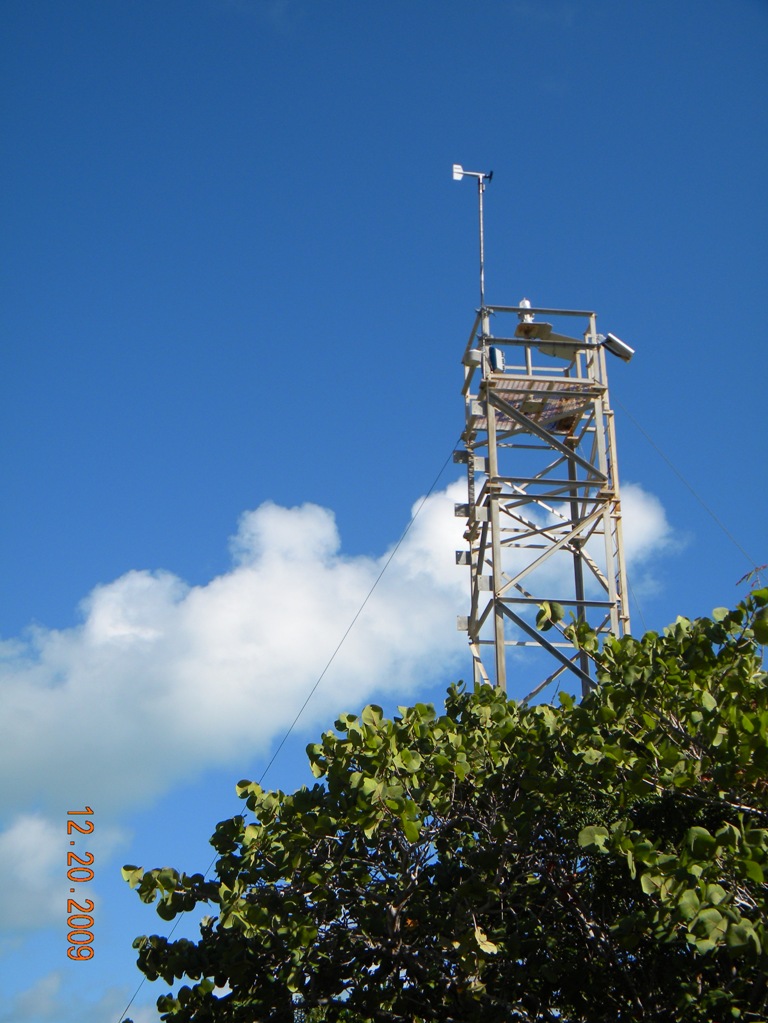
This completes the five-station system, called V.I. Mesonet, which previously included stations at WGOD radio station atop Crown Mountain, on Buck Island in the Charlotte Amalie harbor and on Two Brothers rocks east of St John.
The whole endeavor is being conducted by the University of the Virgin Islands on behalf of the Caribbean Regional Association (CaRA) and is an example of regional, technological cooperation and coordination, providing a greater volume of highly accurate scientific information in real time.
CaRA was established in 2005 by UVI and the University of Puerto Rico-Mayagüez (UPRM) as part of their joint work building the Caribbean Integrated Coastal Ocean Observing System (CarICOOS). The weather network will measure meteorological data, including air temperature, barometric pressure, wind speed, and wind direction.
A company called Weatherflow is doing the installation and coordination of V.I. Mesonet under contract with UVI’s Center for Marine and Environmental Studies. Weatherflow will do data processing, handle quality control, archiving, model development and take charge of disseminating information.
Station reports will be provided almost in real time, after data quality control and computer modeling. Weatherflow will provide high-resolution wind forecasts, calibrated and improved by observations from the V.I. weather stations.
The V.I. branch of CaRA, based at the center at UVI, is making the data available on the internet, according to UVI’s CaRA coordinator, Nasseer Idrisi.
The system is vitally important as researchers in the Caribbean study the effects of climate change on our environment by providing a continuous timeline of the meteorological conditions around the territory, Idrisi said.
"At the same time, the data are vital to the shipping industry: cruise and cargo ships, ferry services and others," he said. The data is available to anyone who wants it and can be used for recreational purposes by boaters, charter boats, surfers and so forth. Because all the data has longitude and latitude coordinates, it is suitable for incorporation into Geospatial Information Systems (GIS) databases too, he said.
The CarICOOS web sites—http://caricoos.org/drupal and http://www.windalert.com—will have the V.I. Mesonet data along with other useful oceanic and atmospheric information in the U.S. Virgin Islands-Puerto Rico region. Right now, the system and its data are experimental and not guaranteed.
"We would like to hear from anyone interested in the data, and we would like to know what they are using the data for so we can develop means to better provide these services to the Virgin Islands community," he said.
The weather station network is just one of several recent technological advancements in regional oceanography. In June, UPRM deployed the first open-water ocean buoy of the ocean-observing system south of Puerto Rico. And for the last two years, robot underwater gliders, looking like little submarines with wings, have been sent out from both the territory and Puerto Rico to roam the depths of the ocean collecting data.
One of those, a glider named Drake, was launched from the UVI and sent to the Canary Islands. The glider is idle in the Atlantic Ocean, awaiting recovery later this month.
The ocean-monitoring buoys and gliders are financed by the National Oceanographic and Atmospheric Administration and are part of the national Integrated Ocean Observing System.
Started as a partnership between UVI and UPRM, CaRA began taking on new partners in 2007, and several departments of the V.I. government are already members. Most recently, the V.I. Resource and Conservation Development Foundation and the Coral Bay Community Council joined CaRA.
Other organizations interested in supporting the ocean-observing system can join, too. For more information, see the CaRA web page, http://cara.uprm.edu.
New Weather Station Systems Now Online in the Territory
Keeping our community informed is our top priority.
If you have a news tip to share, please call or text us at 340-228-8784.
If you have a news tip to share, please call or text us at 340-228-8784.
Support local + independent journalism in the U.S. Virgin Islands
Unlike many news organizations, we haven't put up a paywall – we want to keep our journalism as accessible as we can. Our independent journalism costs time, money and hard work to keep you informed, but we do it because we believe that it matters. We know that informed communities are empowered ones. If you appreciate our reporting and want to help make our future more secure, please consider donating.





